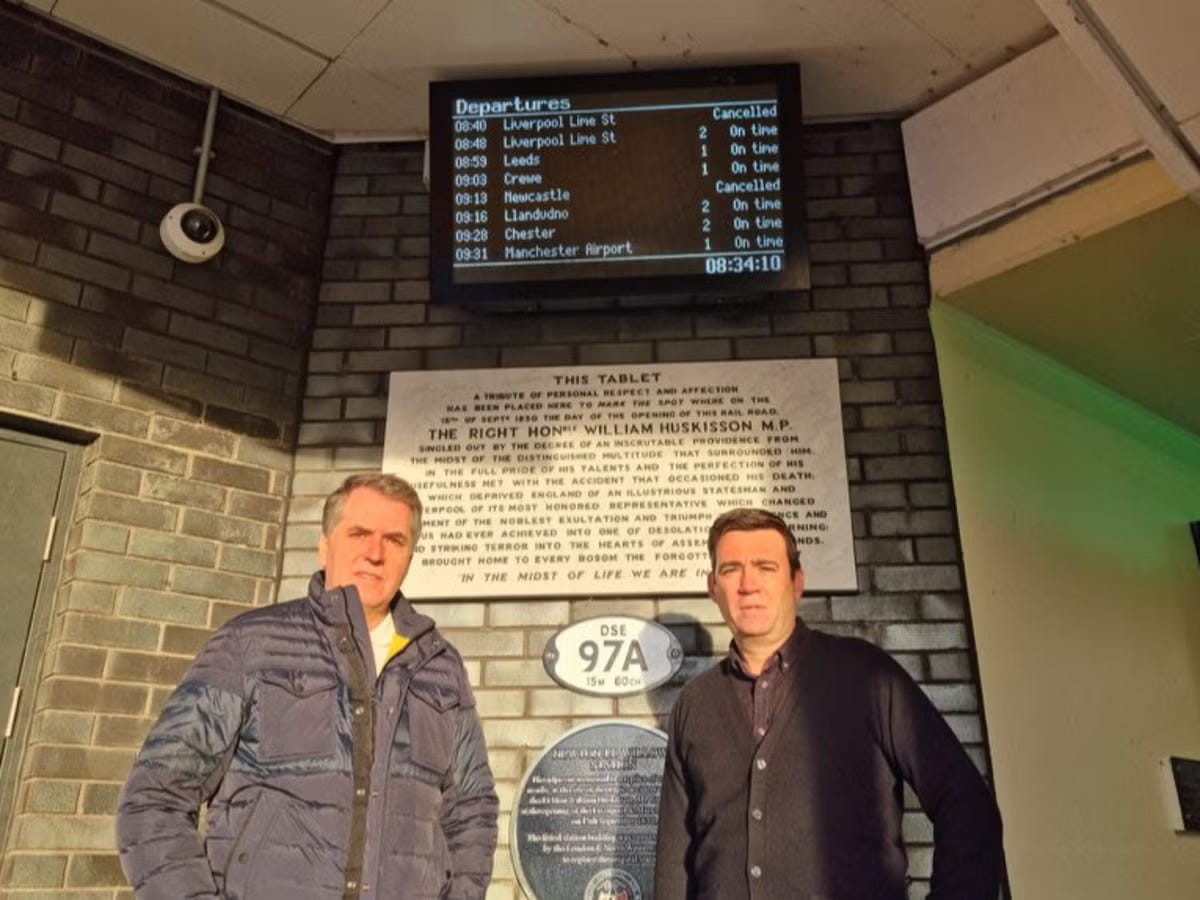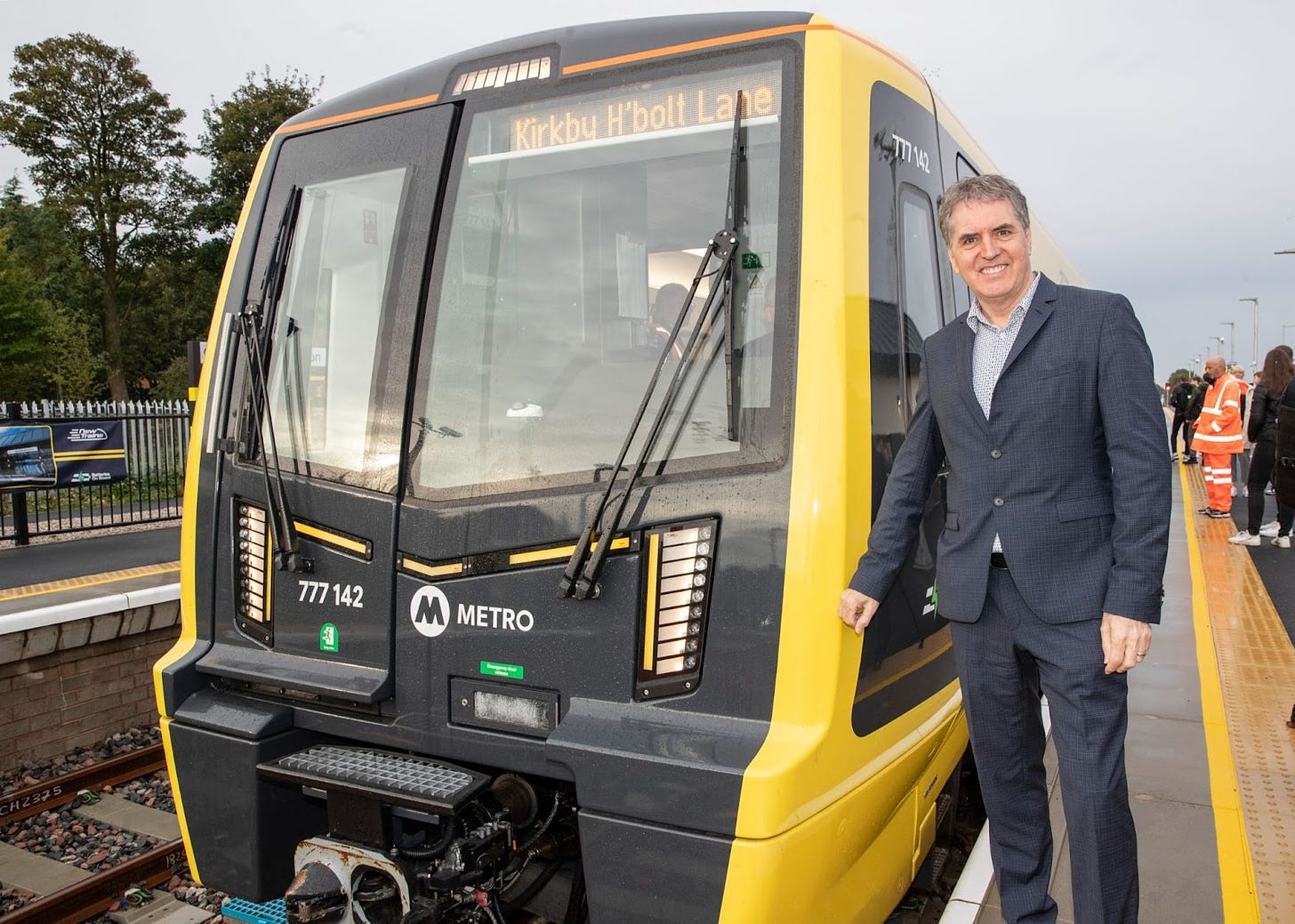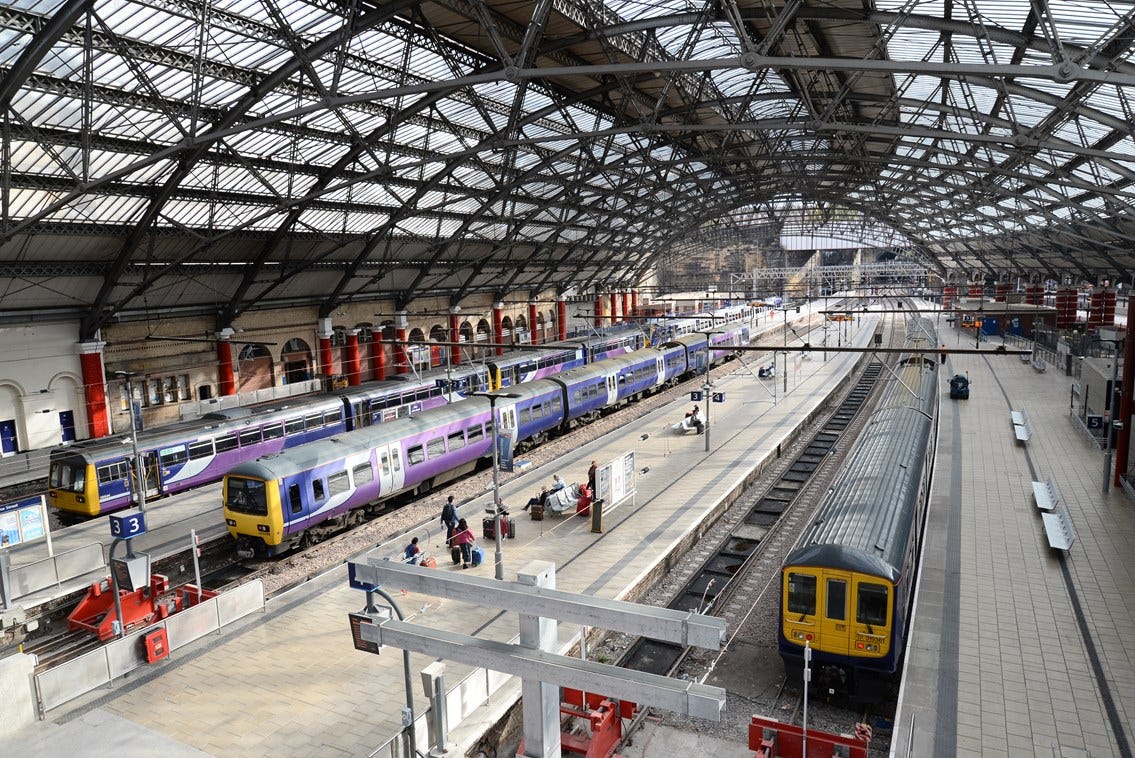Train in vain: what does a future without HS2 look like?
By Jack Walton
Back in the antediluvian days of 2022, I was living and working in Liverpool while my girlfriend was based in Salford. Twice a week, I would take on the Takeshi’s Castle challenge of travelling between the two cities. Despite this being just a 35-mile journey, by the time I would get to Lime Street I usually looked like Tom Hanks in the middle of Castaway.
Suffice to say, the relationship didn’t last. I won’t go as far as to say that the executives of TransPennine Express and Northern malevolently conspired to bring that relationship to an end (I’m told I should look inward on that matter) — all I’m saying is that it would be remiss to rule it out entirely.
The idea that trains in Britain are crap is so deeply embedded in the national consciousness that it’s impossible to imagine a world where things are any different. Crap trains, arguably to the same extent as crap weather, are essential small talk fodder. They’re crucial to our sense of what Britain is. The careers of a thousand middling British observational comics are predicated on their continued crappiness. And up here in the North West, the trains are as bad or worse than anywhere else.
In October 2022, metro mayors Andy Burnham and Steve Rotheram posed for a picture on a train platform between Liverpool and Manchester. They were in a huff. They had been due to attend a conference about the “rail chaos” afflicting the north of England, but were made late when their train was cancelled. Almost exactly a year later, in October 2023, Rishi Sunak — seeking a big announcement to breathe life into his deteriorating leadership — scrapped HS2 at the Tory conference. There was widespread outrage across the north. The one existing plan to lift the north out of its rail misery had been canned. How would they fix it now?
In Liverpool, however, not everyone was so full of gloom. What if scrapping HS2 was actually a good thing? An opportunity even, to right a wrong?
 Steve Rotheram and Andy Burnham in a huff. Photo: Andy Burnham/Twitter.
Steve Rotheram and Andy Burnham in a huff. Photo: Andy Burnham/Twitter.
While Steve Rotheram was launching “a scathing attack on Rishi Sunak's plan”, as the Echo wrote, one man who wasn’t reaching for his pitchfork was Andrew Morris. As the leader of the 20 Miles More campaign — which brought together business leaders to argue that HS2, in its planned form, would disadvantage Liverpool compared to Manchester and Leeds — Morris found himself apart from the pack.
Morris is insistent that the scrapping could be an opportunity for Liverpool. Note the emphasis on ‘could’. Instead, he tells me he’s now lost hope that the oppertunity will be seized upon.
Morris is not exactly an anti-HS2 crusader. He had been lobbying for Liverpool to be linked to HS2 since 2013, when the original plans for the network were first announced. Back then, the business case that his campaign was making caught the attention of Merseytravel, whose then-chief executive Frank Rogers was all ears. Rogers helped create Merseytravel’s own campaign, Linking Liverpool, which set out to sell the city as a sleeping giant which could be unlocked via the network. The campaign argued that the HS2 plans essentially pushed Liverpool out on a limb, but if the city was brought into the fold, it could play a huge role in boosting the nation’s productivity, with a value of £15 billion. But that was a big if.
Now that HS2 has been cancelled, Morris contends that the playing field has been levelled. Manchester and Leeds will no longer be handed a huge advantage over Liverpool, making it easier for the city to compete. To understand why, you need to get a little technical. Essentially, beyond Crewe — which is where Phase 2B of the HS2 line would have begun — there currently are two existing services per hour to Liverpool, three to Manchester, and one to Glasgow. Under the original HS2 scheme, Liverpool would have got nothing beyond Crewe, while Manchester would have got a shiny new line. As such, Manchester would have had the capacity for three double units (these are 400m super trains, which aren’t able to run on the currently existing Victorian railway into Liverpool), while Liverpool was left with two singles. So by scrapping Phase 2B, Manchester remains at 1.5x the capacity of Liverpool, rather than 3x. In relative terms then, that's a win for Liverpool.
 Andrew Morris (left) — leader of the 20 Miles More campaign. Photo: 20 Miles More.
Andrew Morris (left) — leader of the 20 Miles More campaign. Photo: 20 Miles More.
This is not the way Steve Rotheram looks at it. In his view, if the ‘north’ as a collective loses out, then Liverpool loses too. That view is also held by Michael Parkinson, an honorary professor at the University of Liverpool, who helped set up The Northern Way, which originally developed the case for HS2. “Going down the Liverpool vs. Manchester road is dangerous,” Parkinson says. “You’re talking about growing the whole urban system across the north, improving connectivity. Without [HS2] the whole north will suffer, so Liverpool will too.” He points out that Phase 2B of HS2 wouldn’t have been completed until long into the future, and the respective benefits or drawbacks may not have been known until the 2040s.
It’s a debate we circle back to constantly here. Are our fellow northern cities rivals or friends? It came up when we wrote about the English National Opera ultimately choosing to locate to Manchester or Liverpool (or Birmingham) at the end of last year, or when we looked at Liverpool’s disappointing record on attracting inward investment relative to its rivals. But never was it more relevant than with HS2.[1][2]
The opinion-based online magazine Liverpolitan has been banging this drum for a long time, writing in their own HS2 longread that “for too long Liverpool’s interests have been subsumed under a ‘Northwesternist’ agenda centred politically and economically on the needs of Manchester.” The idea of the ‘north benefiting’ is a guise, they wrote, which translates in real terms to ‘Manchester benefiting’.
That’s an argument that Andrew Morris echoes. He tells me Rotheram is a “patsy”, easily taken advantage of by the shrewder Burnham. Frankly, Morris doesn’t have a kind word to say about the metro mayor. “He doesn’t understand that everything now is up for grabs,” he says. “It could’ve been a real positive, but the metro mayor doesn’t have a strategy.”
 Steve Rotheram with the new fleet of Merseyrail trains. Photo: Liverpool City Region.
Steve Rotheram with the new fleet of Merseyrail trains. Photo: Liverpool City Region.
What, exactly, could have been “up for grabs”? Well, apparently much of the £36 billion saved from HS2 will now go into a number of separate localised transport projects across the north. While that total ‘saved’ figure of £36 billion is a bit of a sleight of hand (much of that money was to be borrowed, and Phase 2B wouldn’t have been constructed until the late 2030s) if there is a pot to go around now, Liverpool would hope to be in with a shot.
Many will of course recall the flimsy nature of the ‘Network North’ projects that Rishi Sunak hastily announced would replace HS2. It was easy to laugh at the inclusion of a Metrolink connection to the airport in Manchester, for example, given that one already exists. Regardless, there does appear to be at least some opportunity to get at the new funds, which could be used to improve Liverpool’s transport systems.
The question then becomes what those specific improvements would look like. In 2020, the city region established a commission to help “develop proposals” for a new city centre station. It was led by then-Everton Football Club CEO Denise Barrett-Baxendale, who promised to use her “experience to lead the Station Commission and bring this project to fruition”. Quite what became of this commission is unclear. If you Google “Liverpool station commission” there have been no new results since 2020.
Nonetheless, there are two main options here. One would be to expand Lime Street itself. As Rotheram has correctly pointed out, “Lime Street is absolutely rammed”. This likely involves knocking down the Liner Hotel and car park (no great loss, I hear you shout), which would free up some space, but the expansion would be minimal. Plus, the station’s ‘throat’ is a bottleneck through sandstone cutting, making it harder to expand. Option two is the Edge Hill spur: an old proposal these days reduced to hushed whispers on rail fourms and little more.
The proposal would be to integrate the city lines into the city centre underground network, utilising the disused Wapping Tunnel. That may sound complicated, but according to Martin Sloman, a civil engineer who served as a director for 20 Miles More, it's a potential “game changer”. Why? It would mean trains could run east to west under the city with much greater ease, eliminating two change services.
 Liverpool Lime Street. Photo: Network Rail.
Liverpool Lime Street. Photo: Network Rail.
The longer term plan would be to pay for the spur, rebuild Central completely, then divert all local trains from Lime Street to Central. It wouldn’t be cheap, but then it would likely be cheaper than the £6 billion proposed for a new ‘underground’ station in Manchester. And for that money you’d entirely revamp the ease at which people could traverse the city region. Far-flung parts would no longer feel so detached from the core — journeys requiring two changes would be eliminated. The city region would start to feel like more of a cohesive whole. Its only one idea, but the point Morris wants to make is this: who is pushing these arguments?
Sloman actually thinks you can go further. He laid out his vision in depth in a great article here, but in essence, he believes the current Merseyrail network could be expanded far further and wider than it currently is. “The key point,” he says, “is that for a relatively small amount of money, you could create a huge metro network for Liverpool.” This is because part of this network already exists. Merseyrail was created in the 1970s but, for budget reasons, was never truly completed. It means we’ve only got the basis of a great transport network. [3]
You could, for example, utilise the old Loop Line — which has been fully shut since the 1970s, and is now a dog walking route (maybe dog walkers wouldn’t be so pleased with this one) — to link Merseyrail to underserved parts of north Liverpool. This was part of the original plan, but was dropped after cost overruns and opposition in parliament. It would certainly help with the massive north/south divide across the region. You could even take things further, Sloman believes, branching out to Preston, Warrington, even down to Wrexham.
Compare this to, say, somewhere like Bristol, which has long had its eyes on funding for a new mass transit network. Where that would need to be built from scratch at a cost of £5 billion minimum (some estimates have put the plans closer to £20 billion), “a lot could be achieved for £2 billion at most in Liverpool,” Sloman says.
What’s exciting — or frustrating, if you take Morris’ stance that Liverpool is stuck on its heels — is that transforming Liverpool’s current transport offer into an elite one would actually be quite cheap in relative terms. Of course, any benefits are entirely hypothetical. One thing you could say for HS2 was that it was actually underway at the time of its cancellation. Just because you could get “a lot of bang for your buck” in Liverpool out of whatever residual pool of money now exists, it doesn’t mean that you will.
What frustrates Morris is that Linking Liverpool had already laid a fair amount of the groundwork. These were the conversations they were having, the plans they were trying to lay out. Whether or not HS2 benefitted or didn’t benefit Liverpool — respective to whoever else — is mostly irrelevant now anyway. What isn’t irrelevant is what comes next. “There was a plan, we could have leveraged some of that money,” Morris says. “We could have said we have spade-ready plans to solve regional and national connectivity issues.” There’s that word once again — ‘could’.
References
- ^ when we wrote about (www.livpost.co.uk)
- ^ Liverpool’s disappointing record on attracting inward investment (www.livpost.co.uk)
- ^ great article here (www.liverpolitan.co.uk)
- ^ Share (www.livpost.co.uk)